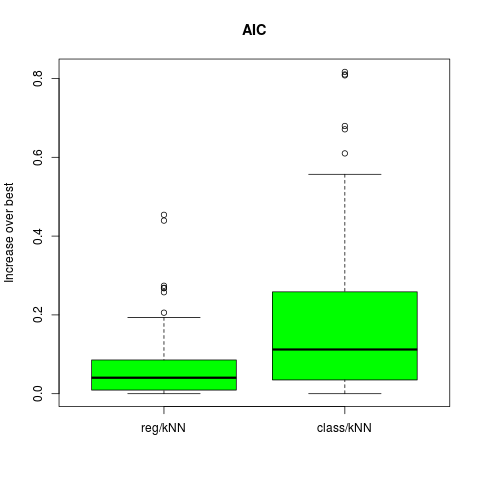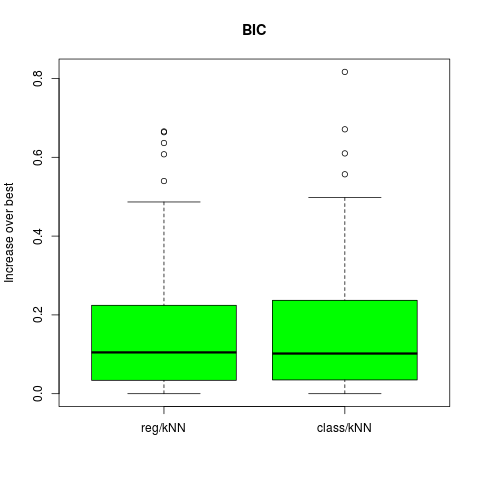模拟:Fig. 7.7¶
| R Notebook | 模拟:Fig. 7.7 |
|---|---|
| 作者 | szcf-weiya |
| 发布 | 2018-01-06 |
| 更新 | 2018-02-04; 2018-02-21 |
本笔记是ESL7.9节图7.9的模拟。
目前完成了AIC和BIC下kNN的回归与分类,剩余情形以后再补上。
问题回顾¶
这是接着图7.3的例子的后续。
采用AIC,BIC和SRM来对图7.3的例子来选择模型大小。对于KNN,模型指标$\alpha$指的是邻居的个数,而对于标着REG的来说$\alpha$为子集大小。采用每个选择方法(例如,AIC),我们估计最优模型$\hat \alpha$并且在测试集上找到真实的预测误差$Err_{\cal T}(\hat\alpha)$。对于同样的训练集,我们计算最优和最坏可能的模型选择的预测误差:$min_\alpha Err_{\cal T}(\alpha)$和$max_\alpha Err_{\cal T}(\alpha)$。 考察下列比值,它表示采用选择的模型和最优模型的误差 并作出箱线图。
几个问题¶
-
估计$\sigma_\epsilon^2$。原书中提到
-
k最近邻的有效参数个数。原书有介绍:$N/k$。
-
$k=1$如何求训练误差。因为$k=1$得到0训练误差,故最小$k$取5。
生成数据¶
# generate dataset
genX <- function(n = 80, p = 20){
X = matrix(runif(n*p, 0, 1), ncol = p, nrow = n)
return(X)
}
# generate response
genY <- function(X, case = 1){
n = nrow(X)
Y = numeric(n)
if (case == 1){ # for the left panel of fig. 7.3
Y = sapply(X[, 1], function(x) ifelse(x <= 0.5, 0, 1))
}
else {
Y = apply(X[, 1:10], 1, function(x) ifelse(sum(x) > 5, 1, 0))
}
return(Y)
}
## global parameters setting
ntest = 10000
B = 100 # the number of repetition
## generate test data
X.test = genX(n = ntest)
Y.test = genY(X.test)
AIC/BIC情形下的kNN分类和回归¶
library(caret)
# for regression
err.aic = numeric(B)
err.bic = numeric(B)
# for classification
err.cl.aic = numeric(B)
err.cl.bic = numeric(B)
N = 80
for (i in 1:B)
{
X = genX(n = N)
Y = genY(X)
# vary the number of neighbor
epe = numeric(46)
epe.cl = numeric(46)
aic = numeric(46) # pay attention!! the effective number is N/k
bic = numeric(46)
aic.cl = numeric(46)
bic.cl = numeric(46)
for (k in 5:50)
{
model = knnreg(X, Y, k = k)
pred = predict(model, X.test)
# for classification
pred.cl = sapply(pred, function(x) ifelse(x > 0.5, 1, 0))
epe[k-4] = mean((pred - Y.test)^2)
epe.cl[k-4] = mean(pred.cl!=Y.test)
# the training error
yhat = predict(model, X)
yhat.cl = sapply(yhat, function(x) ifelse(x > 0.5, 1, 0))
err = yhat - Y
err.cl = (yhat.cl != Y)
aic[k-4] = mean(err^2)*(1 + 2/k * (N/(N-N/k)) )
bic[k-4] = mean(err^2)*(1 + log(nrow(X))/k * (N/(N-N/k)) )
aic.cl[k-4] = mean(err.cl)*(1 + 2/k * (N/(N-N/k)) )
bic.cl[k-4] = mean(err.cl)*(1 + log(N)/k * (N/(N-N/k)) )
}
err.aic[i] = (epe[which.min(aic)] - min(epe)) / (max(epe) - min(epe))
err.bic[i] = (epe[which.min(bic)] - min(epe)) / (max(epe) - min(epe))
err.cl.aic[i] = (epe.cl[which.min(aic.cl)] - min(epe.cl)) / (max(epe.cl) - min(epe.cl))
err.cl.bic[i] = (epe.cl[which.min(bic.cl)] - min(epe.cl)) / (max(epe.cl) - min(epe.cl))
}
## AIC plot
#png("boxplot-AIC-kNN.png")
df.aic = data.frame(val = c(err.aic, err.cl.aic),
case = factor(c(rep("reg/kNN", B), rep("class/kNN", B)),
levels = c("reg/kNN", "class/kNN")) )
boxplot(val ~ case, data = df.aic, col = "green",
main = "AIC", ylab = "Increase over best")
#dev.off()
## BIC plot
#png("boxplot-BIC-kNN.png")
df.bic = data.frame(val = c(err.bic, err.cl.bic),
case = factor(c(rep("reg/kNN", B), rep("class/kNN", B)),
levels = c("reg/kNN", "class/kNN")) )
boxplot(val ~ case, data = df.bic, col = "green",
#dev.off()


其它情形¶
待完成......